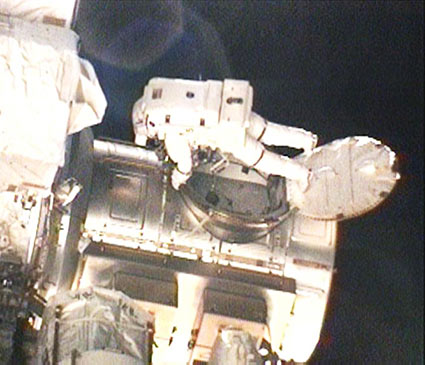For six and a half hours, two astronauts from the Space Shuttle Discovery performed

Two astronauts who are part of the crew of the shuttle Discovery on mission STS-131 - Rick Mastracho and Clay Anderson performed a spacewalk that lasted six hours and 27 minutes. The duo completed all of their main tasks and even progressed with some less urgent tasks.
Among the tasks performed by the two - preparation for removing the old ammonia tank (ATA) and preparations for the installation of a new tank. Among other things, they disconnected the cables and pipes leading to the tank. The old tank will be moved to a side area of the station during the second spacewalk of the two expected the day after tomorrow. Meanwhile, the astronauts inside the station - shuttle pilot James Dutton and astronaut Stephanie Wilson moved the new tank from Discovery's cargo deck to a temporary location on the station after Matsaracho and Anderson loosened the screws of the replacement tank.
Another important task as part of the first spacewalk was the removal of a gyroscope used as part of the station's navigation system, for the purpose of replacing it with a new gyroscope.
The two astronauts also returned the experiment kit in space conditions from the exposed area for experiments in the Japanese Kibo laboratory to the shuttle Discovery for its return to Earth.
Inside the station, members of the STS-131 mission team and members of the International Space Station's 23rd crew continued to transfer equipment and food from the shuttle Discovery to the International Space Station. As I recall, until the end of the shuttle project there are only three tasks left except for the current one.
Today, no updates have yet been given regarding the condition of the KU BAND antenna which broke down during the launch and has not been opened since. As I recall, due to the broken antenna, which is also responsible for the station's radar transmissions, the astronauts on the space shuttle Discovery had to use alternative means to connect to the space station, and they also transmit the television and data transmissions through the space station's communication equipment.

One response
Something I posted on YNET's astronomy forum:
Since there are not many flights left for the space shuttle (I think 3 more) and every such flight becomes historic, I decided to track and document the connection of the shuttle to the space station.
The attached photo is the collection of photos I froze from a process that lasted about an hour (the progress is from right to left and from top to bottom. Some of the photos are from the shuttle and some from the space station. Another photo is from a NASA screen that shows the progress of the connection in a drawing).
The most impressive thing was the performance of a complete "loop" performed by the shuttle in order to photograph damage control by a high-resolution camera located on the space station.
{Most of the photos were taken from the following website: http://www.nasa.gov/multimedia/ /nasatv/ }
http://prdupl02.ynet.co.il/ForumFiles_2/27958640.JPG